My journey thus far...
The Collection

In September 2018, I decided to focus on building an all-MB collection. My goal has been to keep the collection as small in volume as possible, while at the same time demonstrate as much variety as possible in terms of materials, shapes, sizes, nibs, colours, and filling mechanisms designed between 1908 and 1959. The collection is not complete in my eyes - there are a few pieces missing which I intend on hunting down over the coming years. These include a glass nib MG400/420, red dome (no star) ReN, red star ReN, "Capolavoro" imprint model, and streamlined high cap top model, among a few others. I know that adding these pieces will not turn my current collection into an exhaustive one, but it will satisfy me!
As you can see, my collection is modest. However, every pen has a story behind HOW and WHY I acquired it. I have presented the pens below in order of when I acquired them, rather than their production timelines. I don't know if this will be of interest to visitors, to be honest. But, I've always wanted to catalogue my own collection and so I thought why not share the documentation with others too, for whatever its worth!

Montblanc No. 342D
1955-57
The story: I acquired this pen in January 2017. I still remember messaging the seller while I was at my family Christmas lunch! My self imposed maximum budget per pen was $100 at the time, and the 342 was a bit out of reach. This was the first vintage pen I ever bought. This was also the first time I took delivery of a pen via international post! I thought it was a huge risk, but I was just way too tempted. So, I took the plunge! The 3-4 week wait felt like a year! Then I got a call from the post office saying something was wrong with my package and that I should pick it up myself. I was imagining the worst. When I reached, I was handed the package and told that rats ate up one end of the package! I was so confused, until I opened the parcel and realized that the seller had very kindly also included a bar of chocolate! The rats were not after my pen, but the envelope was open and so I was afraid the pen might have fallen out. To my horror, but also relief, the pen was hanging in there literally by a thread! I went home, inked it up and it wouldn’t write. I had very recently been reading about how to tune nibs, so I gave it a shot. Some alignment and grinding later, it wrote like a dream! I might have gone a bit overboard with the grinding and given it a large foot, but that’s what might have also made it super smooth and wet, and the best writer in my collection till date. My experience with the 342D pushed me down the vintage pen collecting rabbit hole!
What makes it unique and distinct in my collection? In the context of my personal collection, this pen is important for a few reasons. First, it is the only example of a “D” or carbon paper, rigid nib in my collection. And second, it is the only example of the super popular 34x series that ushered in the injection moulded thermoplastic design that would soon replace all earlier lathe-manufactured MBs. To learn more about the historical significance of this pen, check out the article I wrote on it -> link.
Montblanc No. 432
1942-46
The story: I had been looking to add a stylograph to my collection for a while but they were rare and expensive for me at the time. Then I came across this lot of two stylos on eBay - both were in bad condition because of which I scored a great deal. However, I was disappointed when expert restorers refused to repair the pen because it was too risky. So, I had no choice but to take on the challenge myself. I couldn’t salvage one of the pens but used it’s parts to complete my current 432 instead. After some pretty complex restoration work (link), I managed to complete this beauty with all period correct parts and got it to working condition as well!
What makes it unique and distinct in my collection? In the context of my personal collection, this pen is important for a few reasons. First, it is a stylograph or “ink pencil”. This adds a unique nib design to the collection. And second, it has the unique “war time” cap that some models had for a very few years. To learn more about the historical significance of this pen, check out the article I wrote on it -> link.


Montblanc No. 146G Meisterstück
c. 1949
The story: The 146 was a Grail pen for me at the time, but I couldn't afford it at full price. Then one day, I noticed this set that had an unrestored 146G, along with a pencil. I wasn’t interested in the pencil and so I made an offer for just the pen. After much negotiation, I managed to purchase the pen for a much lower price than market because the seller had given up on restoring the seized piston on the pen. I figured I’d take my changes and try to pull off a repair miracle! I was a novice restorer though, and this was by far the most valuable pen I had in my collection. It was a high stakes DIY project, but the cost of professional repair was unaffordable at the time. So, I took on the challenge! It was an exciting journey, all of which is documented in this thread on fountain pen network (link). I would not have been successful without the generous help of some veteran members there! It is till today one of the best writers in my collection.
What makes it unique and distinct in my collection? In the context of my personal collection, this pen is important for a few reasons. First, it set the template for the timeless classic torpedo design that inspired the 14x even today, 70+ years later. Second, it adds a beautiful oblique nib to my collection. Third, it has a name engraved on it, which adds even more history and personality to the pen! And finally, it has the medium-length ink window, completing my collection of all three sizes of ink windows. To learn more about the historical significance of this pen, check out the article I wrote on it -> link.
Montblanc No. 644G Meisterstück
1952-57
The story: This pen was offered by a trusted seller on eBay for a relatively low price because it had a slight bend in the barrel and the ink window was missing its lines. I bought it with the hope of pulling off two miracles! One was to bend the barrel back into shape, and the other was to have the ink window lines restored. I was naive to think I could perform either of those tasks. Then I heard about Brad Torell and saw some of his amazing work. We exchanged a few emails, and we had a chat on the phone where he very patiently and passionately explained to me his technical strategies to tackle both issues. I pretended to understand :) After about two months, I received the pen back from Brad. I opened it up and could not believe my eyes! The barrel was perfect and the ink window was pristine! This was the first time I experienced what a master pen maker and restorer was capable of!
What makes it unique and distinct in my collection? In the context of my personal collection, this pen is important because it represents a distinct MB design of the time - the 64x series, with its rolled gold cap. To learn more about the historical significance of this pen, check out the article I wrote on it -> link.


Montblanc No. 244
1946-51
The story: My MB collection had only black pens at this point, and while I admired the coloured models they were out of reach because of my rather tight self-imposed budget at the time. Then one day while surfing the FPN repair forum, I saw a post by a member where he shared that he scored two pens at a flea market - one of them being a green marbled 244 whose piston was stuck and needed repair beyond his capabilities. I connected with him via private message and we negotiated a win-win deal. I would finally add a coloured model to my collection! However, once again, I took the risk of assuming that I would somehow be able to figure out how to restore the piston. Thankfully, the risk paid off! Check out my repair notes -> link. Thanks to this experience I then went on to repair similar MB piston issues for several other collectors.
What makes it unique and distinct in my collection? In the context of my personal collection, this pen is important because it was the first coloured model I owned, but more importantly it was the first non-German manufactured MB in my collection. Also, this pen represents the rather distinct 24X design made in Denmark. To learn more about its historical significance, check out the article I wrote -> link.
Montblanc No. 144, 244, and 149
1950s
The story: The acquisition of these pens coincided with a turning point in the focus of my pen collection. I had been considering selling all my other brands - Waterman, Parker, etc. and shifting focus to exclusively vintage MBs. But my mind wasn’t made up yet. Then, I happened to connect with a UK-based seller that was visiting Mumbai for a few days. He brought a few pens with him. We met at a coffee shop and I didn’t know what to expect. He took out a small box with three pens wrapped in tissue paper. As he unpacked them, my jaw dropped! Out came three of my Grail pens… First, was the 144 dunkel-seegrün (dark sea green) colour more commonly referred to as "green striated”. While they were priced the same as their black counterparts in the 1950s, today the green or grey coloured versions are far more expensive and difficult to find - especially in a condition that retains the vibrancy of their colour. Next came the 149 “silver rings”. This was the OG celluloid 149 whose timeless design has endured till today. And finally, out popped a mesmerizing “Tiger Eye” 244. The “Tiger Eye” color or Arco material is highly desirable among collectors across brands. MB didn’t use the material on many models and so these pens are not easy to find today. So, I thought about it and made an offer - I proposed to exchange my entire vintage Waterman’s collection plus cash for these three pens. After some negotiation, he agreed. I loved my Waterman collection but I was ready to shift focus to an exclusively MB collection now!
What makes it unique and distinct in my collection? I love the 14x design, and wanted to collect all four sizes in all four colours. The green striated “Masterpiece” took me one step closer to this goal. To learn more about the historical significance of this pen, check out the article I wrote on it -> link. With regard to the 149, it is arguably the most iconic and classic design that MB ever made. I mean, it is on permanent display at MoMa! Also, this pen added the tricolor nib to my collection, and it is the largest size in the 14x series. To learn more about its historical significance, check out the article I wrote -> link. Finally, the 244 is important because it is the only Arco material I possess. Also, it represents the distinct Germany manufactured 24x design. To learn more about the historical significance of this pen, check out the article I wrote on it -> link.
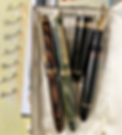
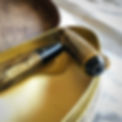
Montblanc No. 44
c. 1950
The story: I stumbled across a wonderful website - barecelonantiques.com - and connected with the owner. He had a lovely collection of Spanish-made vintage MBs. I had never seen so many examples of coloured MBs, and such unique designs too! The honeydew No. 44 stood out and I was very interested in acquiring it. This was the start of a wonderful friendship with Albert, and the acquisition of some beautiful pens subsequently.
What makes it unique and distinct in my collection? In the context of my personal collection, this pen is important because it adds to the variety of non-German models I possess - this one being Spanish-produced. It also adds a distinct colour to the collection - honey dew or golden striated. To learn more about the historical significance of this pen, check out the article I wrote on it --> link.
Montblanc No. 256
1954-56
The story: I was reading Collectible Stars 1946-79 and came across the author’s description of the winged nib as “the most balanced and smoothest writing that has ever been accomplished with a fountain pen”. I was intrigued! So I started doing some more research on the 25x series. I came across many articles in which collectors talked about the tendency of the caps on these pens to crack over time and how it was getting harder and harder to find good examples of them, especially the largest model in the series. So, when I saw one in excellent condition pop up on eBay, I grabbed it!
What makes it unique and distinct in my collection? In the context of my personal collection, this pen is important for a few reasons. First, it represents the 25x series along with its rather unique “winged nib”. Also, this pen has a KOB tipped nib which is an uncommon grind. The ‘K’ nib has an almost perfectly rounded tip, like that of a ballpoint pen. To learn more about the historical significance of this pen, check out the article I wrote on it -> link.


Montblanc No. 216
1955-59
The story: I acquired this Danish manufactured MB from the FPN classifieds. I had recently read the fascinating book - Montblanc in Denmark, and I knew right away that I had to have a coral red Danish MB in my collection! The thing with coral red pens in my experience is that they are not always found with the full vibrancy of their colour intact. This particular pen offered on FPN looked like it was in exceptional condition. Som I grabbed it :)
What makes it unique and distinct in my collection? In the context of my personal collection, this pen is important for a few reasons. First, it represents the 21x Danish series. Also it has the “6” imprint nib. Finally, it is the only button filler in my collection. To learn more about the historical significance of this pen, check out the article I wrote on it -> link.
Montblanc No. 2J
c. 1924
The story: I acquired this pen from the same person that sold me the 144, 149 and 244. Safety pens are my personal favourite - I love how simple the filling system is and I enjoy restoring them too. I didn’t have any octagonal shaped MBs in my collection and so this was going to be a good addition. However, I was disappointed to find that it had a replacement nib. The “J” nib was a unique and rare nib that was supposedly made to be flexible for calligraphy. I bought the pen because it was a nice writer even with the replacement MB nib. However, many months later, I was acquainted with Osman Sümer, and I casually asked him if he might have a “J” nib. To my surprise, he had one in the right size! Nothing like the feeling of “completing” a pen with period and model correct parts!
What makes it unique and distinct in my collection? In the context of my personal collection, this pen is important because it is the only “J” nib I have. To learn more about the historical significance of this pen, check out the article I wrote on it -> link.


Montblanc No. 4 Pneumatic Filler
c. 1927
The story: This story begins with the 136 - it was a grail pen for me at the time but I just couldn’t afford one. So, when I saw an eBay auction for a well priced but non-functioning 136, I decided to take my chances and try to restore it. One of the issues was that the ink window had lost all its stripes. Another issue was that I just couldn’t disassemble the barrel from the rest of the pen. So, I sent the pen to Brad Torelli. He had done some wizard-level work on a previous pen of mine. After several weeks, I received an email from Brad with a picture showing the pen shattered in several pieces. It seems this was due to the carelessness of the postal delivery service. My heart was broken! I decided to have the pen sent to Francis Goossens to make a transparent barrel. I thought it might be cool to see the telescopic mechanism in action. Francis did a fantastic job, as always. As I was showing the pen off on FPN, one of the members reached out to me and asked if I might be interested in an exchange. He offered me a “compressor” - a rather uncommon filling mechanism that MB used for a very short period. However, the pen was quite badly oxidized, and it was missing a clip (leaving the earlier clip portion of the cap discoloured). Also, it didn’t have the correct nib. I accepted the exchange. Over time, I sourced the original clip and correct nib. I also used Hoover’s deoxidizing compound to remove some of the oxidization. Today, it is a decent specimen of a vintage MB pneumatic filler.
What makes it unique and distinct in my collection? In the context of my personal collection, this pen is important because it is the only pneumatic filler I own. To learn more about the historical significance of this pen, check out this article I wrote on MB “Compressors” -> link.
Montblanc No. 0
1922-25
The story: I was very happy with the Spanish-manufactured No. 44 that I bought from Albert earlier. So, I decided to reconnect with him when I was in Barcelona on a family summer vacation. Albert invited me over to his house, which was filled with antiques of all kinds! His vintage pen collection was exquisite - featuring rare MB models manufactured in Spain. However, my eyes fell upon this tiny little No. 0. It looked terribly impractical as a writer, but it was oozing with novelty!
What makes it unique and distinct in my collection? In the context of my personal collection, this pen is important because it is the smallest pen I own. Also, my No. 0 is the only lever filler in my collection. To learn more about the historical significance of this pen, along with other lever filler models, check out this article I wrote -> link.


Montblanc No. 126 PL
1935-38
The story: Not every pen has an exciting story :) This was a purchase off the classifieds section on FPN. At the time, the PL was a Grail pen for me, but finding one with vibrant color and for a good price was very difficult. I guess I got lucky!
What makes it unique and distinct in my collection? In the context of my personal collection, this pen is important because it represents the top tier 12x series whose design I find to be the most elegant of all. Additionally, this pen is the only example I have of the highly desired platinum lined or platinum striped color. To learn more about the historical significance of this pen, check out this article I wrote -> link.
Montblanc No. 2 Eyedropper
Early-1920s
The story: There were only a handful of vintage MB sellers that had websites with pictures and descriptions of pens. Posarro’s website was one of them that I frequented. He was pleasant to deal with and honest. One day, I saw an ebonite MB eyedropper listed - it was slender, modest in size, and had virtually zero oxidation. I love safety pens and eye droppers because of how simple and durable their filling systems are. While eyedroppers were common on many vintage pen brands, they are rarely found on MBs and so I was very interested in having an example of my own.
What makes it unique and distinct in my collection? In the context of my personal collection, this pen is important because it is the only eyedropper filler that I own. To learn more about the historical significance of this pen, check out the article I wrote on it -> link.
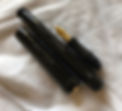
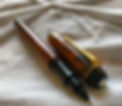
Montblanc No. 422
1932-42
The story: I was offered this 422 about two years after finding my fist stylograph or “ink pencil” (the No. 432 in black). I don’t collect vintage ball pens or pencils or any other type of MB instruments, only fountain pens. But, the stylograph always felt very close to the fountain pen - the filling systems were identical, the bodies were shaped almost identical, and the ink used and the way it dried on paper was identical. Now, I already had a 432 which was a black piston filler stylograph, so I really wasn’t looking to add another ink pencil to the collection, until I set my eyes on this 422! It was a gorgeous mottled red! The pen was sourced at a pen show by my most trusted source - Osman Sümer!
What makes it unique and distinct in my collection? In the context of my personal collection, the 422 is special because it is the only mottled red color pen I own. To learn more about the historical significance of this pen, check out the article I wrote on it -> link.
Montblanc No. 35 Masterpiece
Early-1930s
The story: This No. 35 was offered to me along with the mottled red 422. It's a beautiful and large pen in vibrant coral red made for the Danish market. This series is coveted by collectors for a few reasons, but arguably the most important one is that it marked the inception of the enduring “Meisterstück” or “Masterpiece” brand name for MB’s top-of-the-line collection.
What makes it unique and distinct in my collection? In the context of my personal collection, the 35 is special because it is the only example I have from the original “Masterpiece” collection made by MB. To learn more about the historical significance of this pen, check out the article I wrote on it -> link.


Montblanc No. 142 Masterpiece
1957-59
The story: Now that I had a black 149 and 146G, and a green striated 144, the only 14x series pen missing was a silver or grey striated 142. This would complete the 14x collection in terms of all sizes and colours. The silver striated cost just as much as the black option back in the day, but today it is far more expensive and rare to find. The difficult part was to find an example in condition where the vibrancy of its colour is intact and not starting to oxidize towards shades of brown (very common issue with these pens). The silver striated colour is my favourite of all vintage MB colours!
What makes it unique and distinct in my collection? In the context of my personal collection, this pen is important because it represents one of the most beautiful materials ever used for vintage MBs - striated grey celluloid. Apart from that, it is an example of the size “2” in the 14x series. To learn more about the historical significance of this pen, check out the article I wrote on it -> link.
Montblanc No. 25 Faceted
1939-43
The story: After writing an article on the faceted No. 25 made in Denmark, I really wanted one for my own collection. But these pens are not easy to find. Also, I wanted the plain black one but my experience was that this was even harder to find than the coloured versions. Then one day I happened to see it on one of the websites I used to frequent at the time, and it was there! I grabbed it quickly! Unfortunately, it didn’t have the correct nib when I received it, but I managed to source one many months later.
What makes it unique and distinct in my collection? In the context of my personal collection, this pen is special because it represents a very unique shape in comparison to all other MB models. To learn more about the historical significance of this pen, check out the article I wrote on it -> link.


Montblanc No. 204
c. 1926
The story: While I was putting together an online repository of old MB brochures and advertisements for research, I came across this MB catalog from the 1920s presenting several series of beautiful pens made in Italy. Most of these, if not all, had gold or silver overlay. I had to acquire one example from this catalog for my collection. So, when I saw this lovely 204 with its original case on TenPen.it. The rolled gold overlay on these pens often have small dents because it is quite a light overlay. The example I found was dent free and the price was reasonable so I purchased it. Also, for the record, Letizia is always been a pleasure to do deals with :)
What makes it unique and distinct in my collection? In the context of my personal collection, this pen is important because it is an example of Montblanc manufactured in Italy. These designs and the material are unique compared to the other overlay pens made by MB. To learn more about the historical significance of this pen, check out the article I wrote on it -> link.
Montblanc No. 4 Silver 900 Overlay
Early-1920s
The story: I noticed beautiful examples of a gold overlay and silver overlay MB in the quarterly catalog of a very reputed seller - Gary Lehrer. I had been looking to add these designs to my collection for a while and they are not so easy to come by. So, I pulled the trigger! I waited with eager anticipation, and when the pens arrived I did what I always do - I opened them up to examine. The gold pen checked out OK. The silver one left me a bit confused! The helix rod was not like anything I had seen on previous MB safety pens. After connecting with a few of our trusted experts on vintage MBs, I realized that the mechanism belonged to an Astoria safety pen made by MB during the same period. On further examination, I realized that the overlay design matched that of an Astoria model, rather than MB. Basically, everything on the pen was Astoria except the cap top that had the MB logo instead of the Astoria logo. Gary had no idea of this himself and was prompt to replace the pen with another one of my choice - the large silver 900 overlay MB that we see here!
What makes it unique and distinct in my collection? In the context of my personal collection, this pen is important because it is the only silver overlay pen that I own. To learn more about the historical significance of this pen, check out the article I wrote on it -> link.
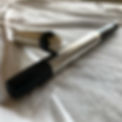
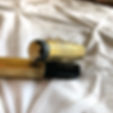
Montblanc No. 4 Gold 585 Overlay
1923-25
The story: I already had a rolled gold overlay pen in my collection, and a silver overlay. A solid gold overlay example was missing. I was quite resistant to buy a 585 hallmarked safety because I knew a large factor in its high price was the value of actual solid gold that adorned it (and I wasn’t interested in jewellery!). But, the overlay designs on these solid gold pens are very unique and exquisite. So, I eventually caved and bought this one along with the silver overlay to complete my collection of metal overlay MBs.
What makes it unique and distinct in my collection? In the context of my personal collection, this pen is important because it is the only solid gold 14c (585) overlay pen that I own. To learn more about the historical significance of this pen, check out the article I wrote on it -> link.
Montblanc No. 22 1/2
Chef D'Oeuvre
c. 1929
The story: This was a purchase off the FPN classifieds section, if I recall correctly. Nothing very special about the pen in terms of size, filler, colour, etc. But, it had a few interesting features. First, was that it was an in-between model number (not 20 or 25). Second, it had the distinct “Chef D’Oeuvre” cap imprint. MB had the “Masterpiece” imprint for English speaking countries, the “Meisterstück” for German speaking markets, the “Chef D’Oeuvre” for French speaking markets, and the “Capolavoro” for Italian speaking markets. Third, it had a double digit imprint nib, which was a distinct design produced by MB on this series of pens.
What makes it unique and distinct in my collection? In the context of my personal collection, this pen is important because it got me closer to having masterpiece tier pens with imprints in all languages - the only one missing was the Italian one. This pen is also the only example of the unique double digit numbered nib in my collection - the “20” in this case. To learn more about the historical significance of this pen, check out the article I wrote on it -> link.
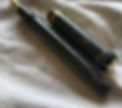
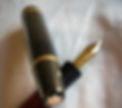
Montblanc No. 235
c. 1935
The story: While doing my research I found that the first model on which MB piloted its piston filling mechanism was the “235”. However, I had never heard of or seen a 235. I asked the experts and they said it was rare that I wold be better off deleting it from my wish list. But I couldn't stop thinking about it. Luckily, one day, my most trusted source for vintage MBs was at a pen show and dropped me a message saying he found my "unicorn" pen!
What makes it unique and distinct in my collection? This pen is historically significant because it was the pilot or prototype in some sense for the “kontrolfüller” piston system that eventually became a mainstay in MB's tier two and three series vintage pens. It is also the only example I have of the rare “5” imprint nib. To learn more about the historical significance of this pen, check out the article I wrote on it -> link.
Montblanc No. 102 G
Mid-1930s
The story: Have I mentioned that I love safety pens :) This one has all my favorite design elements in one - safety mechanism, tie clip, and the distinguished 13x Mesiterstück flat top styling! The larger versions are very expensive and so I was on the lookout for the smallest size for a while before my most trusted source found this one for me!
What makes it unique and distinct in my collection? The 102G is significant in the context of my collection because it is an example of the topmost tier (Meisterstück) safety pens that MB made during that period. To learn more about the historical significance of this pen, check out the article I wrote on it -> link.


Montblanc No. 2
c. 1911
The story: The older the pen, the more fascinating I find it. I have been slowly and meticulously working my way as far back in MB’s manufacturing timeline as possible. This white domed safety pen was a big step in that direction. Not easy to find!
What makes it unique and distinct in my collection? This pen is historically significant because it is an example of MB models before the star logo we know and love came into production. It is also the only example I have of the old "SIMPLO PEN CO" nib imprint. To learn more about the historical significance of this pen, check out the article I wrote on it -> link.
Montblanc No. 138
c. 1942
The story: I had been looking to add a fitting exemplar of the iconic 13x series into my collection for a few years. These pens are rather expensive, especially if you are looking at larger models. Nevertheless, I splurged on a 139 only to find (under closer examination) that it had chemical welding repair marks. So I returned it. Some time later, I acquired the celluloid 149. This got me thinking… I now had a pen with two distinctive elements of the 139 i.e. the silver cap rings and a “9” size nib. The exorbitant price of the 139 didn’t seem well justified to me anymore, considering these pens are really not that rare to find. So, I instead acquired a war time 138. I believe it is much more difficult to find, and it has virtually identical size and design elements to the 139, while having a few unique distinctions of its own.
What makes it unique and distinct in my collection? This pen is historically significant because it is an example of the iconic 13x series. Also, this particular example has a steel alloy nib - the only one in my collection. And, it is the only example I have of the coveted long ink window design. To learn more about the historical significance of this pen, check out the article I wrote on it -> link.
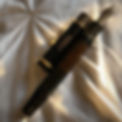

Montblanc No. 224
c. 1935
The story: This pen was not on my list, I will be honest. I was asked to restore an entire collection of rather valuable vintage MBs by an enthusiast, and this 224 was one of them. After restoring the pens, he told me that he intended on selling them. The vibrancy of the green malachite left quite an impression on me - I know how rare it is to find pens of this colour in such good condition. And so I made an offer.
What makes it unique and distinct in my collection? This pen is significant in the context of my collection because it is the only example of the beautiful malachite green colour I possess. To learn more about the historical significance of this pen, check out the article I wrote on it -> link.
Montblanc No. 420 MG
c. 1942
The story: It took me 5 years of patient searching to find an example of a glass nib MB for my collection. These pens are not easy to find! But, once again, Osman Sümer pulled a rabbit out of the hat for me :) I have always been fascinated by vintage glass nib pens. Before I moved to an MB-exclusive collection, I had a bunch of glass nib Haro brand pens from the 1920s/30s that I absolutely loved. They are surprisingly good writers! And so, it was only natural that my MB collection should have a glass nib model too.
What makes it unique and distinct in my collection? This pen is historically significant because it is an example of the "MG" glass nib series. By acquiring it, I have further widened the diversity of nib types in my collection. To learn more about the historical significance of this pen, check out the article I wrote on it -> link.


Montblanc Fabrication Françiase
1940s
The story: A few years back, I acquired several old MB boxes, one of which was marked "Stylo Montblanc" and "Fabrication Française." Initially, I believed this box was for a stylograph (an ink-pencil) that had been imported to France. However, while researching and writing an article about the stylograph, I came across images of some unusual pens. I learned that these weren't just imported; they were actually manufactured in France. This was a revelation, as I had previously thought that pre-1959 MBs were exclusively produced in Germany, Denmark, or Spain. Coincidentally, I stumbled upon one of these pens for sale from a seller friend, and driven by my curiosity, I decided to purchase it!
What makes it unique and distinct in my collection? This pen is significant in the context of my collection because it is the only example I have of a French-made Montblanc. Now, I have at least one example of pens made from every country that MBs were manufactured in. To learn more about the historical significance of this pen, check out the article I wrote on it -> link.
The Simplo Pen
c. 1908
The story: My collection focus for some years has been limited to pens pre-1959. I already had pens that marked the outer limit of this period, but nothing to represent that years when Montblanc started its production. It was my dream to own a pen from the first catalogue published by MB in 1909, and this dream has recently come true!
What makes it unique and distinct in my collection? This pen is historically significant because it is among the first pens ever made by Montblanc. By acquiring it, I now have pens spanning right from 1908-1959. To learn more about the historical significance of this pen, check out the article I wrote on it -> link.
